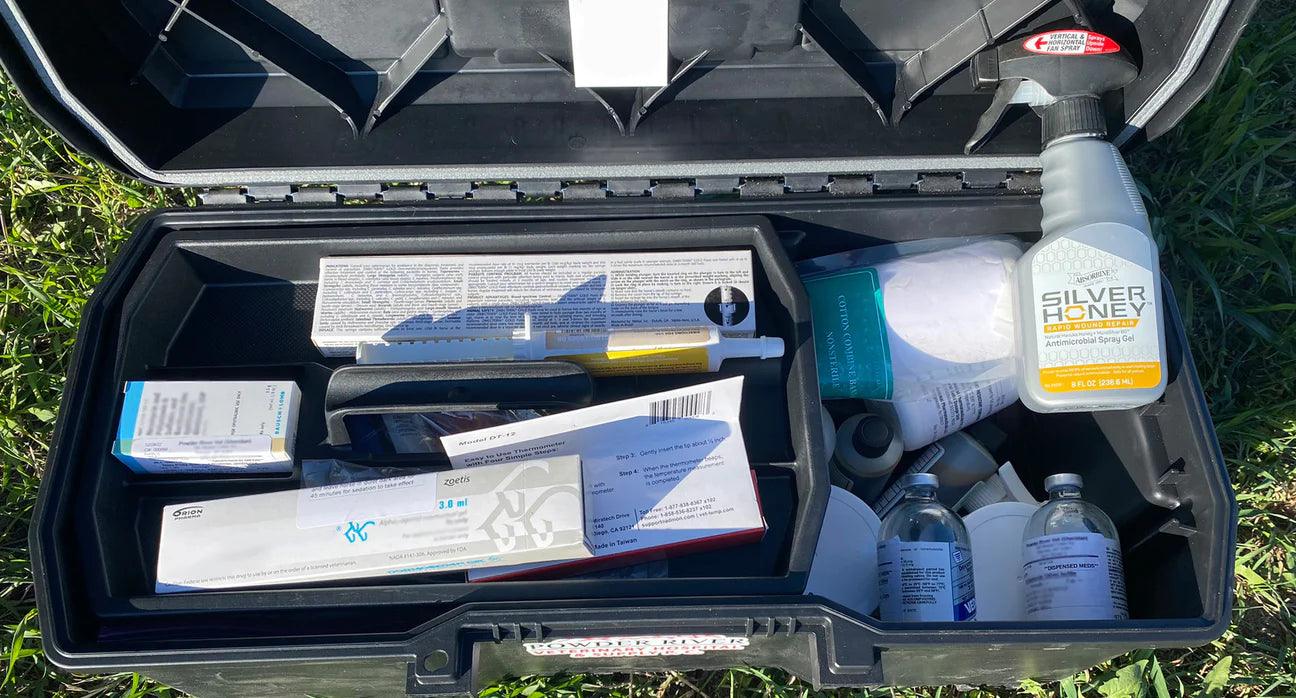Given the chance, a horse could probably find a way to hurt himself while covered in bubble wrap. Good news! You can address minor injuries on your own with a well-stocked first aid kit. Having these basic supplies on hand can help you reduce the risk of further injury until the veterinarian can arrive.
When assembling a first aid kit it’s important to consider all the places you might need to act. That could be at the barn, on a trail ride, or hauling to a show. While this is a basic recommendation, your equestrian lifestyle will determine specialty items to ensure you’re prepared for a variety of scenarios.
BUILDING YOUR KIT
Let’s start with the most common needs. Trees, stalls, fence lines, other horses, and bugs can all cause minor wounds that can effectively be treated on your own.
Basics
To clean and dress a small wound you’ll need:
- Antimicrobial wash
- Topical antimicrobial ointment or spray
- Towels, cotton, and non-stick gauze to clean and dress an injury
- Self-adhesive wraps to secure dressings in place
Essential Supplies
The basics are a good place to start, but veterinarians recommend building a first aid kit with a few more essentials. These additional supplies can be kept in a watertight box and can easily be transported between the barn, trailer and show.
- Roll cotton
- Gauze
- Towels or rags
- Adhesive tape
- Non-adherent wound dressings
- Self-adhesive wraps and standing wraps
- Scissors
- Duct Tape
- Antimicrobial wash and topical
- Eye wash
- Exam gloves
- Hoof pick
- Epsom salts
- Poultice
- Thermometer
PREPARING FOR THE TRAIL
While it’s impossible to take a fully stocked first aid kit along on a trail ride, it is best practice to carry a few key supplies supplies, especially for longer rides. Dense brush and obstacles can easily cause cuts on the legs. There’s a chance brush or downed fences could tangle legs or that a horse will throw a shoe. These are a few items to pack in your saddle bags before hitting the trails.
- Hoof pick
-
Multipurpose tool that includes a knife and pliers
Hoof boot - Antimicrobial topical treatment (like Silver Honey ® ointment)
- Self-adhesive bandages
- Choosing a powerful, bacteria fighting formulation
Having a first aid kit on hand is only the first step in addressing emergencies. It’s imperative to stop bacteria from fueling an infection. With Silver Honey ® spray on gel or ointment you can have peace of mind knowing that it will stop 99.9% of bacteria immediately before it can cause a problem.
Silver Honey® is the first and only product to harness the natural healing power of Manuka Honey and MicroSilver BG®. Available in a spray gel for covering larger areas or ointment for more targeted application, it protects the skin’s natural microbiome, to support fast, comfortable healing cuts, abrasions, sores, rain rot, rashes, fungus, scratches, sweet itch, wounds and burns. The naturally occurring antibacterial qualities of the natural yet powerful ingredients encourages the debridement of wounds to shed dead tissue and promote new tissue growth so your horse can return to his activities.





